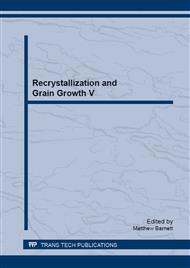p.297
p.303
p.307
p.311
p.317
p.321
p.325
p.329
p.333
Abnormal Grain Growth in Nanocrystalline Materials
Abstract:
Much attention has been generated by nanocrystalline materials and their promise of enhanced properties. However, this class of materials suffers from an inherent instability with respect to thermally induced grain growth. Substantial microstructural coarsening is frequently observed in elemental samples even under ambient conditions, and more often than not, the mode of grain growth in such specimens is abnormal. Although deliberately adding an atomic species that segregates to the grain boundaries has been shown to stabilize the microstructure of nanomaterials to high fractions of the melting point, once grain growth commences, it generally proceeds in a highly abnormal manner in these samples, as well. In the case of Fe-based nanocrystalline alloys, abnormal growth appears to be intimately tied to the alpha-to-gamma phase transformation just above 900°C. For Ni-based segregation-stabilized specimens, however, there is no such allotropic transformation; nevertheless, the microstructure after growth manifests the same telltale signs of abnormality.
Info:
Periodical:
Pages:
317-320
Citation:
Online since:
March 2013
Authors:
Price:
Сopyright:
© 2013 Trans Tech Publications Ltd. All Rights Reserved
Share:
Citation:


